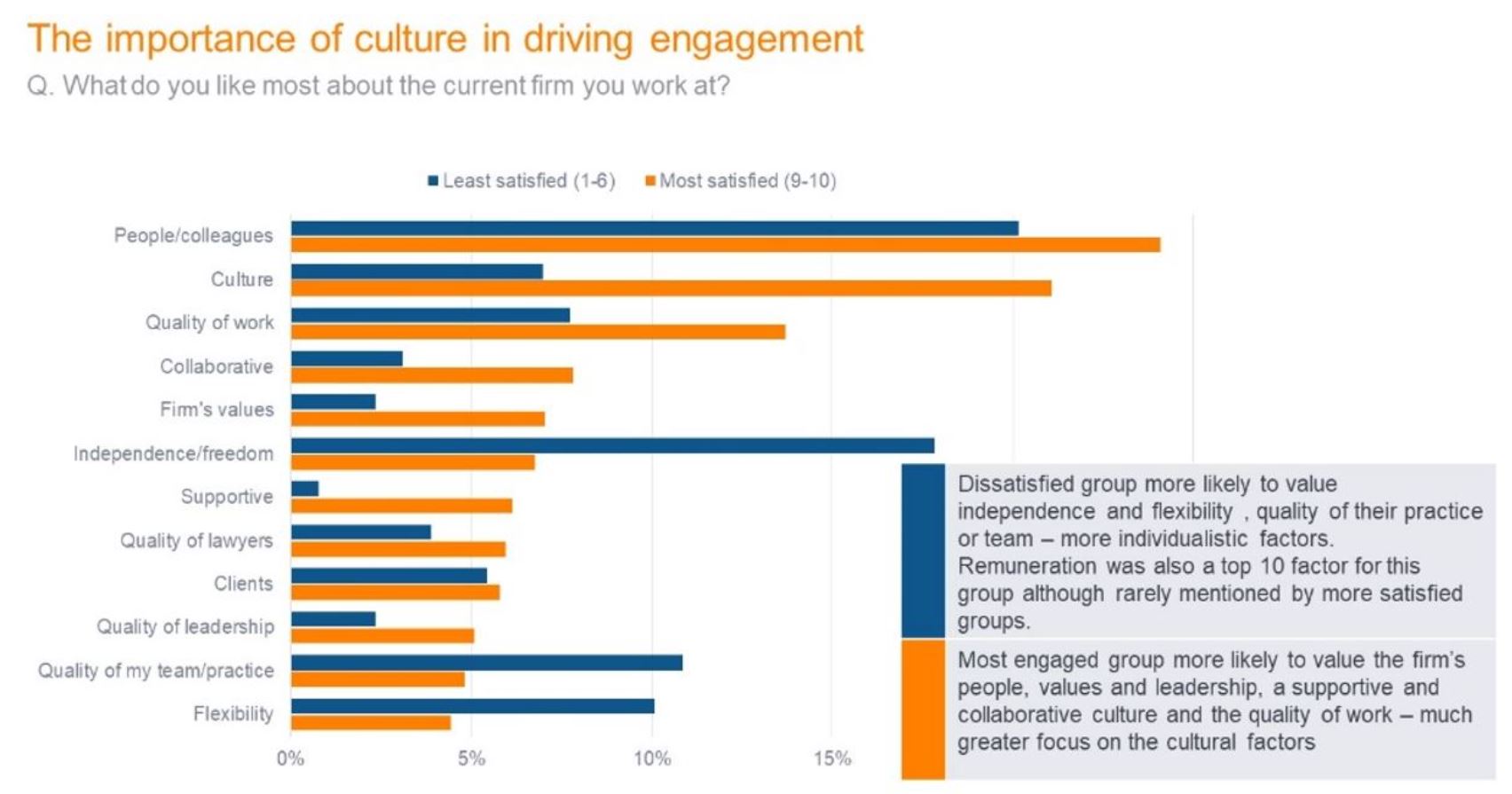Law firms looking to engage retention strategies to keep their top performing lawyers shouldn't overlook the importance of firm culture and inclusion, research shows
In a new blog series, Legal Talent Deep Dives, we will examine the data that points to several strategies that law firms can pursue to increase their bottom line
In today’s legal environment, as law firms try to move through the post-pandemic environment and navigate to something they see as closer to normal, the issue of legal talent remains a hot button topic for firms of all sizes.
Indeed, the number of lawyers considering leaving their current firm is eye-opening. Our research indicates that 21% of those lawyers (mostly partners) that have been nominated as stand-out lawyers by their clients, and 46% of associates are either unsure, somewhat likely, or highly likely to leave their current firm within the next two years.
Not surprisingly, when law firm managing partners get together, the talk is about why their lawyers are leaving — either to competitors, in-house positions, or most troubling, to no position or plan at all. These leaders also discuss how the time and process to replace lawyers that leave has become much longer, more expensive, and more complex.
What is becoming clear in this scenario is that law firms need to find a way to create workplace environments from which lawyers won’t want to leave — an increasingly complex endeavor, that involves addressing issues that are removed from the compensation picture altogether.
To help provide an answer to this dilemma, Thomson Reuters’ recent legal talent research illuminated several pathways that law firms can follow to arrive at a successful talent strategy in the post-pandemic era, including what can be done to retain their stand-out lawyers, and how a focus on engagement and culture — rather than just matching compensation — can make a great deal of difference in firms’ retention efforts.
Our Stellar Performance market research study took an in-depth look at more than 2,400 stand-out lawyers — those nominated as such by clients in Thomson Reuters’ ongoing, randomly sampled global Sharplegal survey — and what can push them to leave their current firms and what can be done about it. Previously in this series, we saw how having just three stand-out lawyers on a firm’s roster can make a great deal of difference to clients and can lead to a four-fold increase in the portion of clients’ legal spend the firm might gain; and what stand-out lawyers see as value within themselves. Now, we turn our attention to the part of our research that detailed how lawyer retention strategies are becoming a much bigger piece of law firms’ profitability puzzle.
Strategies to retain the best lawyers in your firm
During this time of stiff competition for in-demand legal talent, it is more important than ever for firms to guard against high lawyer turnover. Our research underscores the fact that associates are at especially high flight risk right now; and while they themselves told us that compensation is their main concern, our research shows that a host of other factors also contribute to better associate retention. Indeed, these factors are typically cultural, such as flexible working schedules, better communication and engagement, and support for mental well-being — all of which were impacted by the pandemic’s forced pivot to remote working.
For example, remote work meant that mentoring had to be addressed differently and became much more challenging. Without the chance for partners to more regularly have those difficult questions and conversations that can help shape a younger lawyer’s career, law firm leaders had to struggle to sell the idea of becoming a partner more than ever before. There may be two main reasons for this. First, given the lessons of the pandemic, many lawyers (of all ages and status) are more circumspect in how they spend their working hours, whether they’re willing to endure long commutes, and how they balance their work with their life outside of work. And second, the rise and growing reputation of new roles within many law firms involving technology, legal operations, talent management, and more have offered side steps off the partnership ladder that now also can provide different kinds of rewards and recognition.
The power of firm culture
As we looked more widely at stand-out lawyer retention in our research, it appears that many law firms overlook the role their own leadership and strategy-setting plays in either pushing lawyers away or keeping them within their firms. Firms need to genuinely engage and communicate with lawyers at all levels to ensure firms don’t leak great talent.

As the research shows, those lawyers that regarded themselves as most satisfied in their current roles at the firm felt that cultural issues were much more important than did those lawyers who considered themselves least satisfied with their jobs. In fact, the most satisfied lawyers cited people and colleagues, workplace culture, and the quality of work they’re given as the top three areas that give them the most satisfaction.
Least satisfied lawyers, on the other hand, cited people and colleagues, independence or freedom, flexibility, and quality of their team or practice as top areas of satisfaction.
Building toward an inclusive culture
Given that firms’ efforts toward creating this more accommodating work culture for their lawyers can pay dividends in retention and — just as importantly — curb the hiring cost of recruiting, hiring, and on-boarding new talent, the key question becomes one of how can firms create an atmosphere in which their top lawyers want to remain?
Focusing on several aspects of culture — such as enhancing the overall tenor of working life, making all lawyers feel included and visible, and ensuring that all lawyers and staff are being treated in a manner that’s friendly and respectful — is a great place to begin. Couple that effort with clearly articulated opportunities for career progression, advancement, and professional growth, and firms will have significantly contributed to higher employee engagement among stand-out lawyers and others.
These efforts will require, of course, a dedicated initiative that enlists management, offers management training, and instills more flexibility than firms may be used to offering. However, firms must ensure these foundations are in place to maintain an engaged workforce and defend against other firms poaching their stand-out talent. Indeed, our findings indicate that, almost one-half of lateral moves of top lawyers are instigated by the hiring firm — and this figure is even higher among recruits who were not actively considering a move.
Today, no law firm can pursue strategies to enhance profitability or ensure stability if they do not have a strategy in place to retain their best lawyers and avoid the cost and disruption of new hires and constant turnover. Keeping their best lawyers satisfied and engaged within a welcoming workplace culture is the surest way law firms can keep that talent at the firm.
You can learn more about how your firm can better understand the value of its stand-out lawyers as part of its overall talent and client service strategies, here.






